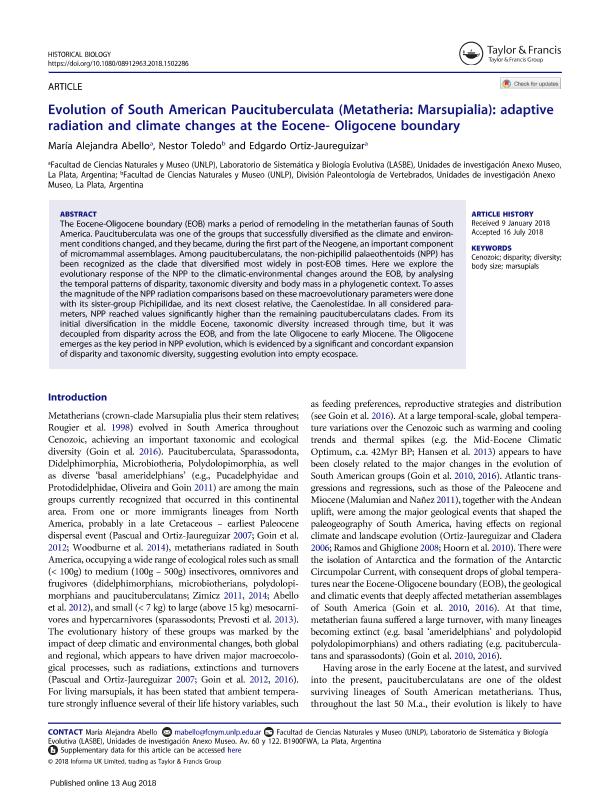Artículo
Evolution of South American Paucituberculata (Metatheria: Marsupialia): adaptive radiation and climate changes at the Eocene- Oligocene boundary
Fecha de publicación:
08/2018
Editorial:
Taylor & Francis Ltd
Revista:
Historical Biology
ISSN:
0891-2963
e-ISSN:
1029-2381
Idioma:
Inglés
Tipo de recurso:
Artículo publicado
Clasificación temática:
Resumen
The Eocene-Oligocene boundary (EOB) marks a period of remodeling in the metatherian faunas of South America. Paucituberculata was one of the groups that successfully diversified as the climate and environment conditions changed, and they became, during the first part of the Neogene, an important component of micromammal assemblages. Among paucituberculatans, the non-pichipilid palaeothentoids (NPP) has been recognized as the clade that diversified most widely in post-EOB times. Here we explore the evolutionary response of the NPP to the climatic-environmental changes around the EOB, by analysing the temporal patterns of disparity, taxonomic diversity and body mass in a phylogenetic context. To asses the magnitude of the NPP radiation comparisons based on these macroevolutionary parameters were done with its sister-group Pichipilidae, and its next closest relative, the Caenolestidae. In all considered parameters, NPP reached values significantly higher than the remaining paucituberculatans clades. From its initial diversification in the middle Eocene, taxonomic diversity increased through time, but it was decoupled from disparity across the EOB, and from the late Oligocene to early Miocene. The Oligocene emerges as the key period in NPP evolution, which is evidenced by a significant and concordant expansion of disparity and taxonomic diversity, suggesting evolution into empty ecospace.
Palabras clave:
BODY SIZE
,
CENOZOIC
,
DISPARITY
,
DIVERSITY
,
MARSUPIALS
Archivos asociados
Licencia
Identificadores
Colecciones
Articulos(CCT - LA PLATA)
Articulos de CTRO.CIENTIFICO TECNOL.CONICET - LA PLATA
Articulos de CTRO.CIENTIFICO TECNOL.CONICET - LA PLATA
Citación
Abello, María Alejandra; Toledo, Néstor; Ortiz Jaureguizar, Edgardo; Evolution of South American Paucituberculata (Metatheria: Marsupialia): adaptive radiation and climate changes at the Eocene- Oligocene boundary; Taylor & Francis Ltd; Historical Biology; 8-2018; 1-18
Compartir
Altmétricas




